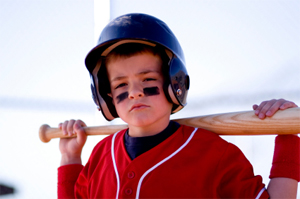November 21, 2011
Promoting Safety In Youth Sports

By Michael D. Shaw
People of a certain age might wonder how they survived their childhood. During those years, the design of most automobiles was anything but geared toward safety. Seat belts did not come into widespread use until the 1960s, and dashboards in certain 1950s models seemed to resemble the inside of an Iron Maiden.
No one had ever heard of a bicycle helmet, and kids rode their bikes then more than they do now. Parents thought nothing at all about sending their youngsters out on various errands, and no child would be caught dead with his parent walking him to school.
As to sporting activities, the only common protective gear were football helmets and shoulder pads, along with the so-called tools of ignorance, used by baseball catchers. You didn’t hear much about injuries, and there are some likely reasons for this. There was much less media back then, and there were also far fewer youth sports organization. In fact, the real emergence of youth sports would occur with the offspring of the baby boomers. Interest and participation in youth sports has grown dramatically ever since.
With more kids participating—often under the vicarious scrutiny of their parents—youth sports have become intensely competitive. Unfortunately, injuries are probably more frequent than you might think. Here are some figures from Safe Kids USA…
- More than 30 million children participate in sports each year in the United States.
- More than 3.5 million children ages 14 and under receive medical treatment for sports injuries each year.
- Among athletes ages 5 to 14, 15 percent of basketball players, 28 percent of football players, 22 percent of soccer players, 25 percent of baseball players, and 12 percent of softball players have been injured while playing their respective sports.
- Children who do not wear or use protective equipment are at greater risk of sustaining sports-related injuries. Inappropriate or unavailable equipment are reasons for children’s not wearing protective gear.
While not thought of as contact sports, hospital emergency departments treat more than 95,000 baseball-related injuries and 30,000 softball-related injuries among players under age 15 each year. The scariest baseball-related injuries involve blows to the head and chest. While batting helmets have been required for decades, the consequences of chest trauma have been less publicized.
A rare, but often fatal condition called Commotio Cordis occurs as a result of blunt force trauma (generally a projectile, but it can also be a fist) to the area surrounding the heart. Research, using six to eight-week-old domesticated juvenile swine, has shown that timing is everything.
The highest incidence of ventricular fibrillation produced by striking the precordium with an object similar in size and weight to a baseball occurs when the impact is delivered within a 20-millisecond window that occurs 10-30 milliseconds before the T-wave peak. This window represents only about 4% of the cardiac cycle in an individual engaged in activities, who has a heart rate of 120 beats per minute.
In a recent case, 13-year-old Little Leaguer Hayden Walton from Winslow, Arizona was killed in May, 2011 when a baseball hit him in the chest as he was attempting to bunt. Five years earlier, Steven Domalewski, a nine-year-old pitcher from Wayne, New Jersey was struck in the chest by a batted ball, and sustained substantial brain damage, due to lack of oxygen.
In the wake of the Domalewski tragedy, the use of baseball heart guards has become more popular, and improved designs came on the market. One new company in this space is East Brunswick, New Jersey based SportsGuard. I recently spoke with CEO Michael Green.
In addition to offering a heart protector, the company also supplies a cushioned grip system (for baseball bat, lacrosse, and hockey stick handles) as well as a unique baseball cap insert—providing head protection for baseball pitchers and fielders. As a concerned parent of a youth baseball player, he was motivated to start SportsGuard. Green said:
Many parents, if they’ve been to enough games, will see some level of injuries. It happens that my partner and I had the expertise to follow-through, and to design and introduce these products. I think part of what we’re looking to do is to enhance the confidence of the youth players. When they feel well-protected, that gives them more confidence to do what they want to do on the field.
It is my hope that the tremendous zeal many parents have for winning can be matched with a zeal for safety.

